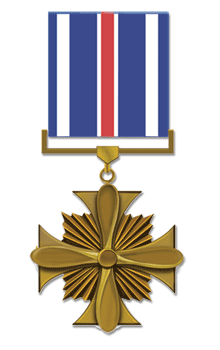 Establishing Authority
Establishing Authority
The Distinguished Flying Cross was established by Act of Congress (Public Law 446, 69th Congress), approved July 2, 1926, and implemented by Executive Order 4576 signed by President Calvin Coolidge on January 28, 1927. This law was amended by Section 4 of Public Law 234 (approved on July 30, 1937) to permit the Coast Guard to award the Distinguished Flying Cross in its own right (members of the Coast Guard could previously receive the Distinguished Flying Cross only "while serving with the military or naval forces"). Public Law 234 was implemented by Executive Order 7786 signed by President Franklin D. Roosevelt on January 8, 1938.
Effective Dates
The Distinguished Flying Cross has been in effect since July 3, 1927. However, Executive Order 4601 signed by President Hoover on March 1, 1927, provided that for "any act of heroism or extraordinary achievement performed on or before July 2, 1926, the Distinguished Flying Cross shall not be awarded after July 2, 1929, nor unless the recommendation therefore shall have been made on or before July 2, 1928."
Criteria
The Distinguished Flying Cross may be awarded to military members who, while serving in any capacity with the Armed Forces, distinguish themselves by heroism or outstanding achievement while participating in aerial flight. To be awarded for heroism the act must involve voluntary action in the face of danger and be well above the actions performed by others engaged in similar flight operations. If awarded for extraordinary achievement, it must have resulted in an accomplishment so exceptional and outstanding as to clearly set the individual apart from his or her comrades or from other persons in similar circumstances. Awards of the Distinguished Flying Cross by the Army are only made to recognize single acts of heroism or extraordinary achievement and not to recognize sustained operational activities against an armed enemy.
Order of Precedence
The Distinguished Flying Cross is worn after the Legion of Merit and before the Soldier's Medal, Navy and Marine Corps Medal, Airman's Medal, or Coast Guard Medal.
Devices
- Army and Air Force: Additional awards are denoted by oak leaf clusters.
- Air Force: A bronze "V" device to represent valor may be worn on a Distinguished Flying Cross awarded for valor. Use of the "V" device was authorized by the Secretary of the Air Force on June 30, 2004 and is retroactive to September 18, 1947. Individuals previously awarded the Distinguished Flying Cross for heroism (as indicated on the citation, certificate, or order) are now authorized to wear the "V" device. There is no requirement to have a personnel office verify entitlement.
- Navy, Marine Corps and Coast Guard: Additional awards are denoted by gold stars five-sixteenths of an inch in diameter, and the Combat Distinguishing Device (a bronze letter "V") may be authorized for qualifying service rendered after April 4, 1974.
Designers
The Distinguished Flying Cross was designed by Arthur E. DuBois and Elizabeth Will, both of the Army's Institute of Heraldry.
First Recipient
- The first recipient of the Distinguished Flying Cross was Captain (U.S. Army Reserve) Charles A. Lindbergh, who received medal number 1 on June 11, 1927, from President Calvin Coolidge in a special ceremony on the grounds of the Washington Monument.
- The earliest act for which a Distinguished Flying Cross was awarded occurred much earlier. By Act of Congress (Private Law 313) approved December 18, 1928, Wilbur and Orville Wright were awarded the Distinguished Flying Cross for the first manned flight at Kitty Hawk, North Carolina on December 17, 1903.
Description and Symbolism
Obverse
On a bronze cross pattee one and a half inches across, a four-bladed propeller one and eleven-sixteenths inches across the blades; in the re-entrant angles, rays forming a one inch square. The cross is suspended by a plain, straight suspender.
Reverse
The reverse is blank, leaving space for engraving the recipient's name.
Ribbon
The ribbon is predominantly blue, with a narrow band of red bordered by white in the center. The edges of the ribbon are outlined with equal bands of white inside blue.